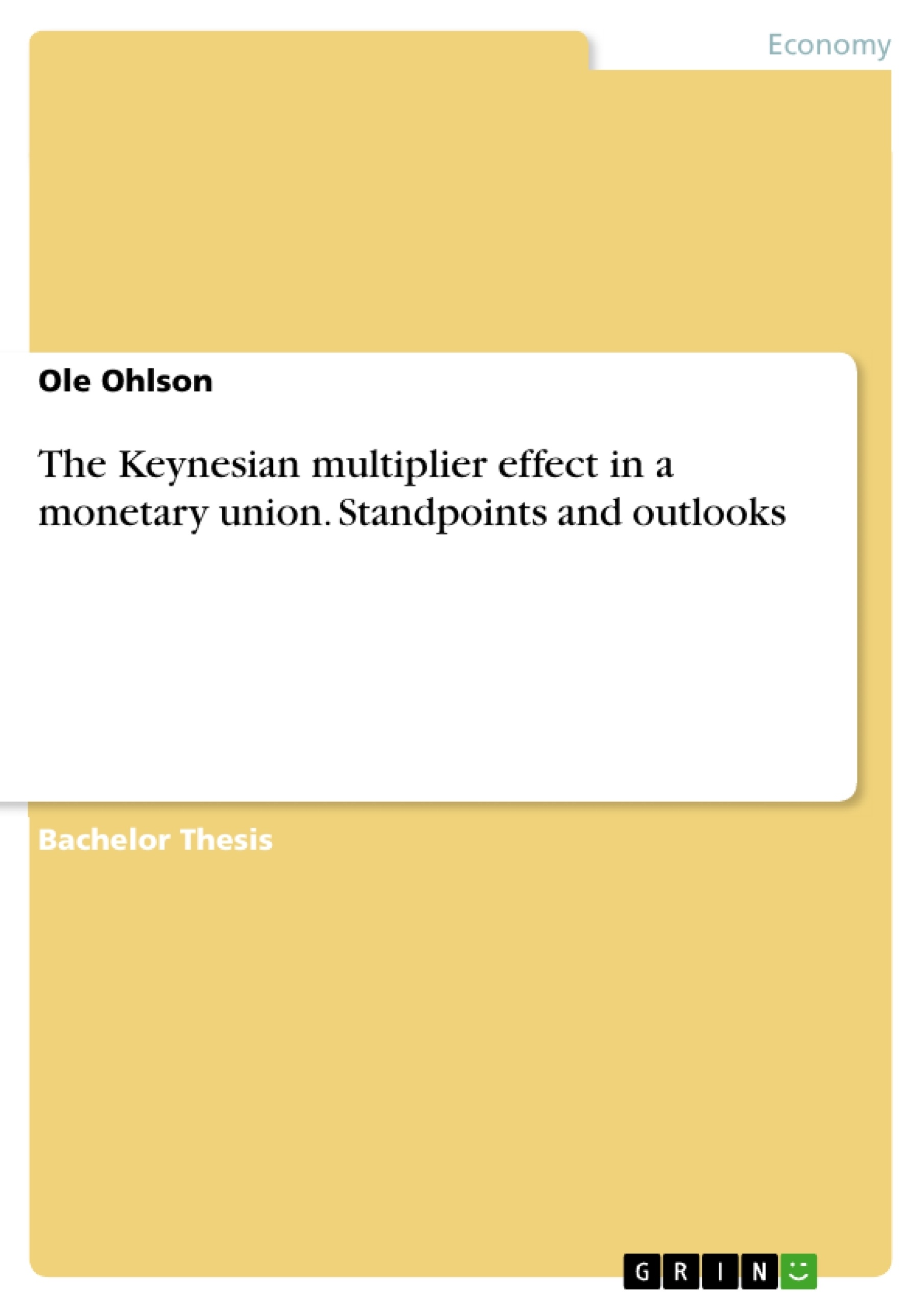This thesis aims at giving a broad outlook on fiscal discussions and standpoints concerning crises which might occur and ultimately aims at answering the following question: How can financial authorities shape public spending and what are the steps necessary? – Lessons learned from the global financial crisis of 2008.
The Keynesian multiplier process is a concept which was first introduced by Richard Kahn and later on carried further by John Maynard Keynes. This concept was rather simple and very intuitive; if a government increases its spending, the resulting output will increase as well. This became especially relevant in times of crises, when governments were aiming at raising their output. The analysis of how government spending would affect output became omnipresent and there are different standpoints in the literature concerning this, most of them focusing on different aspects, such as the timing of news, spillover effects to other countries, the general environment of the economies and also different model approaches to estimate said multiplier as good as possible and to include as many different determinants as possible.
Table of Contents
- 1 Introduction
- 2 Literature Review
- 2.1 The Keynesian Multiplier Effect
- 2.1.1 General Explanation
- 2.1.2 Foundations and Macroeconomic Groundwork
- 2.2 State of the Literature
- 2.3 Concluding Literature Review and Answering Questions
- 2.1 The Keynesian Multiplier Effect
- 3 Comparison of Countries and Model-Analysis
- 3.1 Government Spending and Output
- 3.2 Model Analysis on Different Parameters
- 3.2.1 Smets-Wouters Model (2003)
- 3.2.2 Del Negro et al. Model (2014)
- 4 Outlook and Conclusion
Objectives and Key Themes
This bachelor thesis aims to analyze the Keynesian multiplier effect within a monetary union. It investigates the impact of government spending on output, considering various macroeconomic factors and utilizing established economic models. The study compares findings across different countries and model specifications to provide a comprehensive understanding of the multiplier's behavior in a monetary union context.
- The Keynesian multiplier effect and its theoretical foundations.
- The impact of government spending on economic output within a monetary union.
- Comparative analysis of the multiplier effect across different countries.
- Model-based analysis of the multiplier using the Smets-Wouters (2003) and Del Negro et al. (2014) models.
- The role of monetary policy in influencing the multiplier effect.
Chapter Summaries
1 Introduction: This chapter likely introduces the topic of the Keynesian multiplier effect in a monetary union, outlining the research question, methodology, and structure of the thesis. It sets the stage for the subsequent chapters by providing context and background information on the significance of understanding the multiplier within a monetary union framework.
2 Literature Review: This chapter reviews existing literature on the Keynesian multiplier effect. It covers the general explanation and theoretical foundations of the multiplier, providing a comprehensive overview of macroeconomic groundwork. The chapter likely synthesizes existing research to establish a context for the thesis’s unique contribution, potentially highlighting gaps or controversies in the existing literature that this thesis will address.
3 Comparison of Countries and Model-Analysis: This chapter presents a comparative analysis of government spending and output across different countries within a monetary union. It then employs the Smets-Wouters (2003) and Del Negro et al. (2014) models to analyze the impact of various parameters on the multiplier effect, potentially including factors such as monetary policy reaction functions, interest rate smoothing, and the share of consumption. The chapter aims to provide a quantitative assessment of the multiplier's behavior under different scenarios.
Keywords
Keynesian multiplier, monetary union, government spending, economic output, macroeconomic models, Smets-Wouters model, Del Negro et al. model, monetary policy, fiscal policy, comparative analysis.
Frequently Asked Questions: Keynesian Multiplier Effect in a Monetary Union
What is the main topic of this academic paper?
This bachelor thesis analyzes the Keynesian multiplier effect within a monetary union. It investigates how government spending impacts economic output, considering various macroeconomic factors and using established economic models. The study compares results across different countries and model specifications to understand the multiplier's behavior in a monetary union.
What are the key themes explored in the paper?
Key themes include the theoretical foundations of the Keynesian multiplier, the impact of government spending on output within a monetary union, a comparative analysis of the multiplier across different countries, model-based analysis using the Smets-Wouters (2003) and Del Negro et al. (2014) models, and the role of monetary policy in influencing the multiplier effect.
What models are used in the analysis?
The paper utilizes the Smets-Wouters (2003) and Del Negro et al. (2014) macroeconomic models to analyze the multiplier effect. These models allow for a quantitative assessment of the multiplier's behavior under different scenarios and parameter variations.
What is the structure of the paper?
The paper is structured as follows: Chapter 1 introduces the topic; Chapter 2 reviews existing literature on the Keynesian multiplier; Chapter 3 compares government spending and output across countries and performs model-based analysis using the Smets-Wouters and Del Negro et al. models; and Chapter 4 offers an outlook and conclusion.
What countries are included in the comparative analysis?
The specific countries included in the comparative analysis are not explicitly listed in this preview. This information would be detailed in Chapter 3 of the full thesis.
What are the key findings (as per the preview)?
The preview does not provide specific quantitative findings. The full thesis will contain the detailed results of the comparative analysis and model simulations.
What are the key words associated with this research?
Key words include Keynesian multiplier, monetary union, government spending, economic output, macroeconomic models, Smets-Wouters model, Del Negro et al. model, monetary policy, fiscal policy, and comparative analysis.
What is the objective of this research?
The objective is to provide a comprehensive analysis of the Keynesian multiplier effect within a monetary union, considering both theoretical foundations and empirical evidence from different countries and macroeconomic models.
- Citation du texte
- Ole Ohlson (Auteur), 2021, The Keynesian multiplier effect in a monetary union. Standpoints and outlooks, Munich, GRIN Verlag, https://www.grin.com/document/1223960



